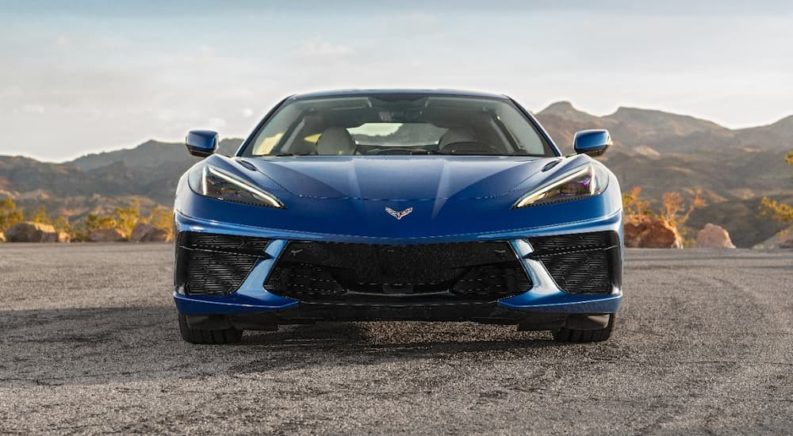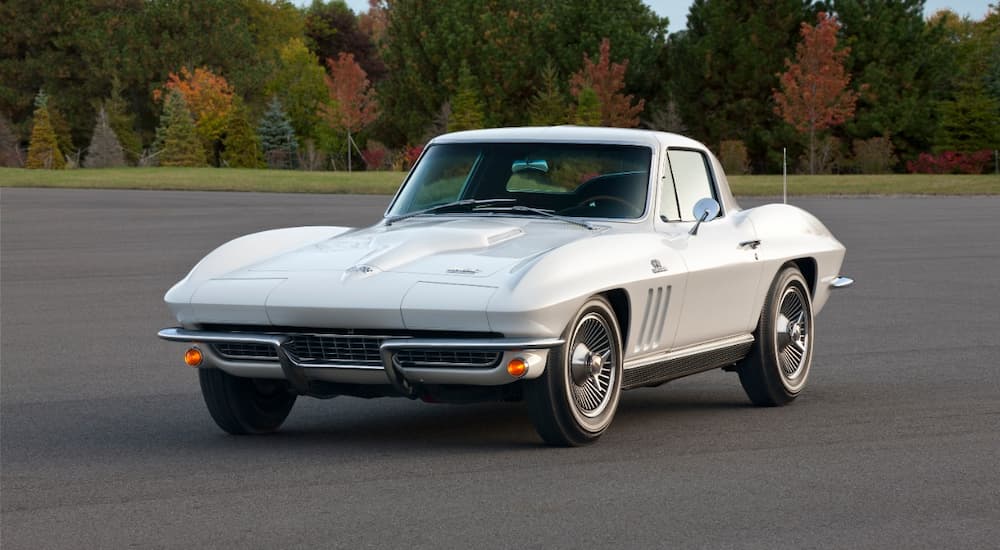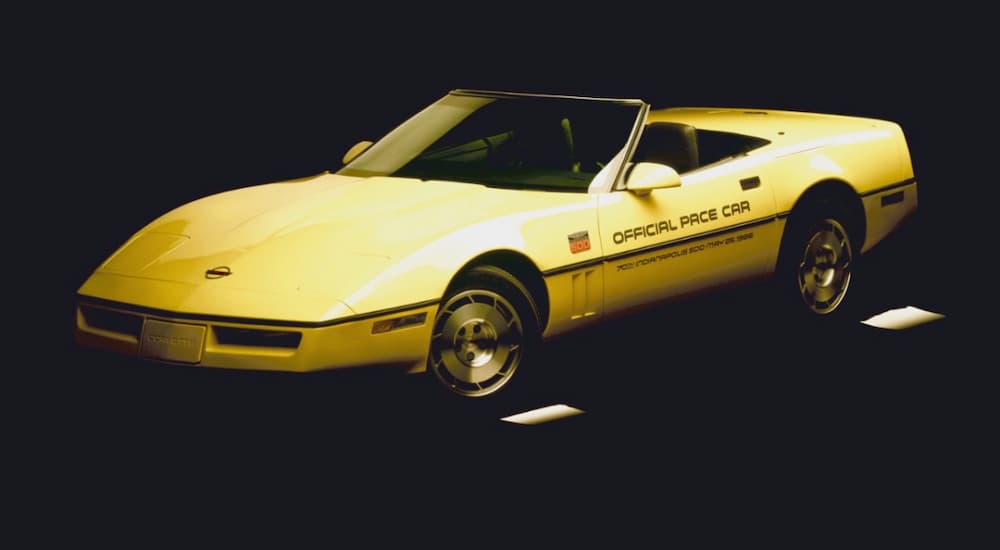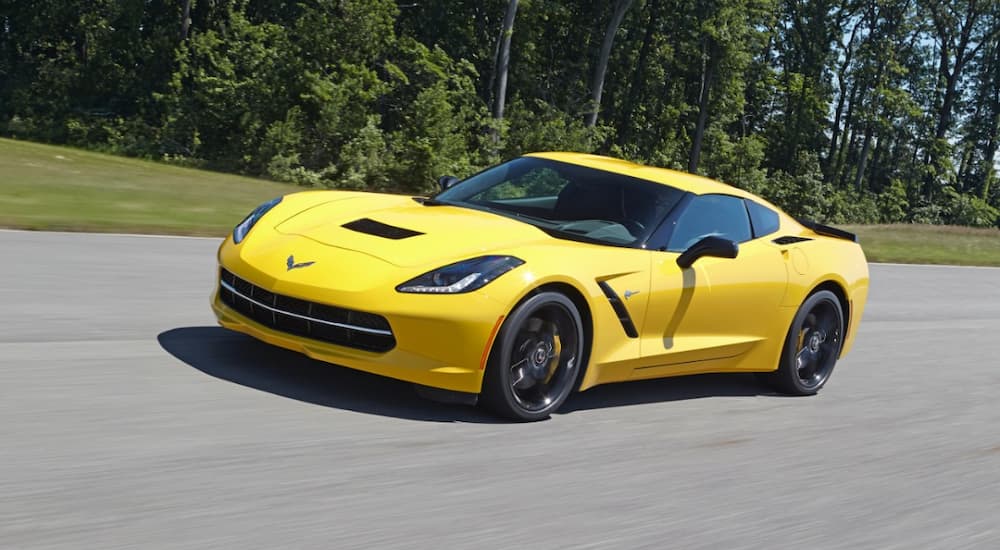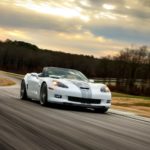For almost 70 years, the Chevy Corvette has captured the hearts and minds of millions. Distinctive swooping lines, iconic taillights, the engine’s rumble and roar – all have made the Corvette a sports car for kids to dream about. Unfortunately, the ‘Vette has a bit of an “odd-man-out” reputation – that it’s the “poor man’s Ferrari” or some kind of “old guy’s car.” There’s no doubt that Chevy’s engineers are hell-bent on out-performing the best brands Europe has to offer, and it’s probably true that most buyers are older folks who are finally treating themselves to the ‘Vette they’ve always wanted; younger buyers may find it too expensive or impractical to be worthwhile. Still, any buyer would have a hard time walking away once they let a Chevy dealer try to change their mind and put them in a ‘Vette.
That’s because the modern Corvette, the 8th or C8 generation, is as attainable as it’s ever been but boasts mind-boggling performance numbers in part thanks to finally having the mid-engine layout that early ‘Vette designers always wanted. I’m going to leave the details of the C8 Corvette for another post, though, because today, I want to dig into the idea that the Corvette is a poor man’s Ferrari. We’ll cover data from every generation of Corvette, including power, acceleration, and pricing, compared against a benchmark Ferrari of the era and the median US income of the time, adjusted to 2019 dollars. If we take “poor man’s Ferrari” to mean a vehicle with comparable styling and performance on an average budget (vs the top 5% of earners, considered here to be Ferrari’s target market), which of Corvette’s 8 generations lives up to or exceeds that reputation?
C1 vs 250 GTE
As iconic as it is now, the C1 Corvette took a while to catch on with consumers despite a price tag that amounted to only $30,000 of modern money. It’s lucky for us that Chevy executives continued to push their engineers to improve the design, which they did. Over the years of 1953 – 1962, the first generation of the ‘Vette developed significantly and was a firmly established sports car by the end of the ’50s.
For comparison, the Ferrari 250 needs little introduction – some may know the GTO version as the most valuable car on the planet. The most popular was the GTE with two rear seats, selling for a mere $12,600 ($111k in today’s coin) – nearly 4 times the cost of a ‘Vette.
While the small Italian V12 couldn’t be more different from Chevy’s legendary small-block V8, the numbers don’t lie – the stallion’s 240 hp was easily matched by many early ‘Vettes. The weight, width, and wheelbase of each vehicle were identical too, and unsurprisingly, the 0-60 mph estimates are in the 6.5 – 8 second range for each, though some sources indicate the Corvette was faster. On the financial side, the C1 ‘Vette was worth 76% of the median American income at the time. You’d have to be over the 93rd percentile of income in the early ’60s for the 250 GTE to be worth the same to you as the Corvette was to middle America.
Poor Man’s Ferrari Rating (PMFR): Certified PMF
Badge: Black stallion on an orange background
C2 vs 275 GTB
The short-lived 2nd generation Corvette, the first to go by the name Sting Ray, is an all-time iconic design. It was longer and lower than the C1, with bigger engine options rating up to 435 hp and performance reported at 4.5 – 6.0 second 0-60 times and 155 mph top speed, but at a barely increased price of $4,100 on average. With rising wages in the mid-’60s, that was only 67% of the median income, making this the most accessible Corvette ever.
Something else was new, thanks to the styling. While one could argue that the C1 almost looked like a 250 GTE, the fastback design of the C2 makes its profile a clear American cousin of the Ferrari 275 GTB, our benchmark competitor. The GTB had a V12 engine that only reported 280 hp, much less than most ‘Vettes, but weighing 900 lbs lighter enabled it to crack a 6.7 second 0-60 time and a 145 mph top speed (you may notice those are worse than the numbers I found for the ‘Vette). Smaller than the 250 in every way, the 275 GTB still commanded $14,500 in the ’60s. You’d need to be making $21,500 per year, the 95th percentile income, for this Ferrari to fit your budget like a Corvette fit an average worker’s.
PMFR: Unverified BTF (Better Than Ferrari)
Badge: Black stallion with a winky face
C3 vs 308 GTB/GTS
The most popular Corvette by sales was the Stingray generation of 1968 – 1982 (the Stingray name was, in fact, stylized differently from the C2 version and only applies to ’69 – ’76 models), and it had the longevity to prove it. The oil crisis of the ’70s plus rapid inflation saw the MSRP of the Corvette skyrocket from $4700 in 1968 to over $18,000 in 1982 and led to the release of the only sub-200 hp Corvette engines after the C1.
The C3 is easily recognized as a muscle car. It’s narrow, low, and long, with a 3520 lb curb weight that makes it the heaviest ‘Vette before the C7. Despite some weak engine options, the C3 also offered a 460 hp 7.4 L V8, the biggest Corvette engine on record and the most powerful until the C6. It doesn’t claim a high top speed but still claims a 6-second 0-60 time.
The C3 competes against the Ferrari 308 GTB, a Ferrari that almost looks like a Lambo (gasp!). Despite a smaller, weaker engine than the 275, the 308 GTB claimed a higher top speed of 155 mph and a 6.2 second 0-60 time. It was low, short, and wide, every inch the handling-focused sports car, and it’s the last Ferrari on this list to weigh under 3000 lbs.
Financially, the C3 Corvette was the least accessible of any generation, pricing at 92% of the median income during its sales run. Now, this is likely skewed a bit due to its 14-year tenure and the wild economic changes that occurred in that span, but applying the same filter to the $45,000 Ferrari puts its owners squarely in the 95th percentile, so I think the comparison holds. However, major differences in style and character make the Stingray a very different beast.
PMFR: Horse of a Different Color, not a Ferrari
Badge: A red Chevy flag crossed over a checkered flag
C4 vs Testarossa
Both cars in our next faceoff dominated the sports car scene of the late ’80s and early ’90s with long runs as their manufacturer’s signature offerings. The C4 Corvette took a big step towards sports car-dom by shedding some weight and changing to a more track-friendly stance. While it lost the over-7 L V8 option, its 5.7 L engine could still crank out over 400 horses, making it significantly quicker than the C3 with a 5.4 second 0-60 time and a top speed of 158 mph.
The legendary Testarossa is the image of Miami Vice and needs little introduction. This thing was just cool. Its 390 hp boxer-12 engine made 390 hp and was good for a 5.2 second 0-60 time with a top speed of 180 mph. As a true supercar priced at $181,000, it was 6x the cost of the C4; however, the C4 itself was also relatively expensive, with the average price of about $30,000 falling at 90% of the median income. As such, a 5-percenter would still have found the Testarossa as palatable for the budget as the C4 was to the common man, making them equally affordable to their respective markets.
PMFR: Certified PMF
Badge: Black donkey on a gold background
C5 vs 360 Modena
I have to admit that I’m salivating more than a little bit as I dial up the 5th comparison of this review. If somebody said to me, “Here’s all of the Ferraris, which one do you want?” it would be a 360 Modena or Spyder. This was my formative-years Ferrari dream car. The 360 was lighter than the Testarossa with very slightly different proportions, exhibited a sculpted flowing body style, and carried a smaller but more powerful engine that screamed to 60 in 4.3 seconds and all the way up to 189 mph for only $140,000.
However, Chevy had finally shaken off the cobwebs of the crises of the late 20th century. The C5 Corvette was the longest and widest Corvette to date, weighed less than it had since the ’50s, and offered no less than 345 hp. Now a true sports car, it cracked the 5.0 second 0-60 barrier and made over 170 mph for prices under $50,000. Improved wages made it more affordable than previous generations at only 75% of the median income. While it wasn’t quite as quick or fast as the 360, the C5 set the tone for the 21st century Corvette, and with the 360 Modena pricing at 75% of the 96th percentile income, the Ferrari was marginally less accessible for their traditional target market.
PMFR: Certified PMF
Badge: Seabiscuit on sunshine yellow
C6 vs F430
The C6 Corvette was more of a development on the C5 than a total redesign, with emphasis on improving performance over reinventing the look. The most significant change is probably the engine lineup, which ranged from 6 to 7 liters in displacement and started at 400 hp for the as-light-as 3073 lb Corvette. Performance models were tuned to over 638 hp, finally cracking the 500 hp mark and sending the C6’s 0-60 time down to 4.2 seconds. Perhaps even more impressive was the top speed: 1-8-6 mph.
Unfortunately, Chevy was still a full step behind Ferrari. The C6 could hang with a Modena, but it was up against the F430, which incorporated F1 technology to wrangle 483 hp from a 4.3 L engine, making a 3.6 second 0-60 time and a top speed of 196 mph. The looks were still good – proportions and styling were largely unchanged on benchmark Ferraris from 1999 to 2020 – but the $171,000 sticker price made the F430 even more exclusive than the 360. That’s because the C6 Corvette was worth 78% of the average American’s income – at sticker price, only 3% of Americans could afford an F430 that easily.
PMFR: Certified PMF
Badge: Black stallion – close-up, showing only the head – on a gold background
C7 vs 458 Italia
This is it. This is the one! The resurrection of the Stingray name, a long, wide, and tall body, the heaviest Corvette ever designed, and a 6.2 L V8 engine, starting in the low $50,000s from 2014 to 2019, is finally going to put Ferrari in their place. Angular features foreshadow the design language of the future, and a maximum of 755 hp from the supercharged LT5 engine in the ZR1 model enables a mind-boggling 214 mph top speed, blasting past the 200 threshold. Even the base 455 hp engine propelled the ‘Vette to a 3.8 second 0-60 time, yet the low price of entry was at 73% of the median income, making it the most accessible Corvette since the C2!
On the other hand is a modest Italian supercar named the 458 Italia. You might have heard of it. A little longer, wider, and heavier than the F430, the benchmark Ferrari of the early ‘10s wrenched well over 550 hp from its 4.5 L engine and claimed a 3.0 – 3.3 second 0-60 time depending on the edition. There’s one downside – the top speed was paltry 202 mph. Arrivederci Italiano; ciao, 458 Americano.
One last thing – the 458 Italia was expensive. If the middle American had to spend 73% of their income on the Corvette, a prospective Ferrari owner looking to spend the same percentage of their income would need to be making $300,000 a year. That’s the 98th percentile! Even 5-percenters are looking at their budget and thinking to themselves that the C7 doesn’t sound so bad right about now.
PMFR: Verified BTF
Badge: Black stallion wearing a victory wreath on a glittering gold background
C8 vs 488 GTB
They finally did it! Finally, without a doubt, Chevy offered a Corvette that was more than a poor man’s Ferrari. They can rest now, right? Wrong! Because they finally got the green light to make the Corvette the mid-engine supercar it was always meant to be! The C8 is badass; there’s no other way to say it. I thought the first one I saw was a Ferrari until it drove by, albeit one that got pixelated to give it those incredible angular looks. There’s no Z06 or ZR1 model yet, so the base 490-ish hp is about all we’ve got – however, the widest Corvette ever also shed a few pounds and manages an eye-popping 2.8 second 0-60 time. Car and Driver themselves describe the performance as Ferrari-like.
Ferrari can punch back with the 488 GTB, the excellent successor to the 458 Italia, but even the 710 hp version of its powertrain only rates a 2.85 second 0-60 run. That’s right – the lower, lighter, significantly more powerful Ferrari is slower than the ‘Vette! Add in that the pricing of the C8, at 75% of the median income once again, is more accessible to the masses than the 488 is to the 5%, and I just don’t see the merit of the PMF argument anymore.
PMFR: Verified BTF
Badge: Black stallion with a checkered flag coat racing into a sunset
Time to Talk About a Rich Man’s Corvette
The “poor man’s Ferrari” reputation hasn’t exactly “dogged” Corvette for years – in what way is it bad to be considered an accessible equivalent to the most legendary automaker on Earth? It has been said, however, that beating Ferrari on the track and on the road was the goal of Chevy engineers from the get-go.
A Ferrari is never going to be as accessible as a Corvette. It’s in the DNA of the vehicle. However, if one considers the Corvette to be marketed to the average American and Ferraris to the top 5% of wage earners, then in the 21st century, the Corvette has become the more accessible, more achievable target of the two. Not only that, but massive performance improvements have made the C7 and C8 Corvettes objectively as good as or better than their Ferrari counterparts! I think it’s time to let the “poor man’s Ferrari” nickname go and instead label the stallion as a “rich man’s Corvette.” Better luck next time, Enzo.

